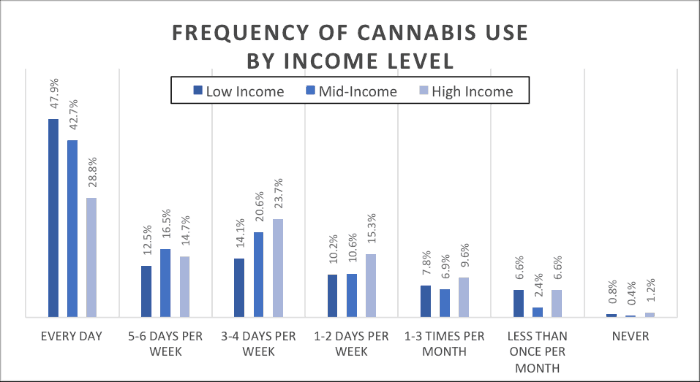
Low-Income Users*: A Worthwhile Investment
Guest post by Bethany Gomez and Jamie Schau of the Brightfield Group
In considering potential markets to target, investors might overlook low-income consumers given their limited budgets and corresponding limited spending capacity. But to overlook this consumer group would be a mistake. According to data collected by Brightfield Group from over 1,200 medical marijuana patients throughout California in 2016, low-income users make up nearly a third of marijuana patients, are loyal customers, and tend to use more product per person than higher-income consumers do. Furthermore, as most branded products are competing in the Standard or Premium segments, the Economy segment is wide open.
* For the purposes of this study, low-income users were considered those who were unemployed or making less than $30,000 per year. Mid-income: $30,000-74,999 annually. High-income: $75,000+ annually.

Low-income patients use more often
Nearly half (47.9%) of low-income consumers use marijuana every day, versus less than 30% of high-income consumers. This phenomenon may take place for several reasons, one being that low-income users – a majority of whom report being unemployed or unable to work full-time – can partake more freely in marijuana use outside of work hours than mid-career professionals who must be in the office 40+ hours per week. Another might be that those with more serious or debilitating medical conditions – and presumably generating less income –have greater and/or more frequent need for medication and are thus more prone to using daily. Regardless, using various tactics to appeal to the budget consumer market will give investors, manufacturers and dispensary owners access to a good deal of eager customers with a large appetite for product.
Few brands are competing in this space
Emerging leaders in the branded cannabis space are largely seeking to differentiate themselves on their premium inputs and (e.g. Kiva, Bhang, Caviar Gold) continue to pursue the Premium and Standard product markets, few are seizing the opportunity to capture low-income customers in the Economy brand space. Low-income users are largely left purchasing unbranded products, which may leave them receiving inconsistent and unreliable cannabis experiences, leaving this market space rife with opportunity. Even more encouragingly, low income users are similarly brand-loyal when compared to higher-income consumers , thus any brand that can effectively tap into the Economy market and win the loyalty of this consumer group would likely see rapid and sustained gains.
Branded flower and portfolio diversification
In the short-term, dispensaries and manufacturers seeking to attract this consumer group should begin offering discounts or budget pricing on a variety of products, especially flower – a low-income favorite. Branded flower offers a great opportunity to tap the economy market, as costs can be lower for flower versus infused products, a savings that can be passed on to the patient. Branded flower, however, has the advantage of being able to deliver a consistent experience to the patient, which is something that consumers across all income ranges are concerned with. Existing manufacturers should consider adding an economy line to their portfolio; by leveraging their existing manufacturing capabilities and distribution networks, they could cut down on the cost of production of infused products and pass these savings on to the consumer, while still achieving reasonable profit margins. Ultimately, although profit margins may be lower on individual products sold, the budget user will make up a worthwhile portion of any successful cannabis entrepreneur’s portfolio of sales.
[1] 13.6% of low income users were considered “highly loyal”, versus 14.8% of higher income users. Respondents were considered “highly loyal” if they responded to the question: “How often do you purchase (specific brand/product) versus other cannabis products?” with “50% of the time or more”, and those who responded “Strongly Agree” or “Agree” to the psychographic question “I’m willing to buy products from a brand I trust, even if those products are more expensive”.

About the authors:
Bethany Gomez is the Director of Research for Brightfield Group, a strategic market research firm focused on the cannabis industry. Bethany has extensive experience in quantitative and strategic research, specializing in the market research of the consumer goods industry. Prior to joining Brightfield Group, Bethany worked with a leading FMCG market research firm, managing the company’s syndicated research of industries such as packaged foods, alcoholic drinks and tobacco in Mexico. Bethany holds a Bachelor’s Degree in Political Science from the University of Wisconsin and a Master’s Degree from University of San Diego’s School of Global Policy and Strategy, focusing on Quantitative Analysis and Management.
Jamie Schau attained a B.A. in International Studies and an M.A. in International Development from the University of California, San Diego. Since early 2015, she has been a market analyst with Brightfield Group, where she performs quantitative and qualitative analyses of various aspects of the U.S. marijuana market.
